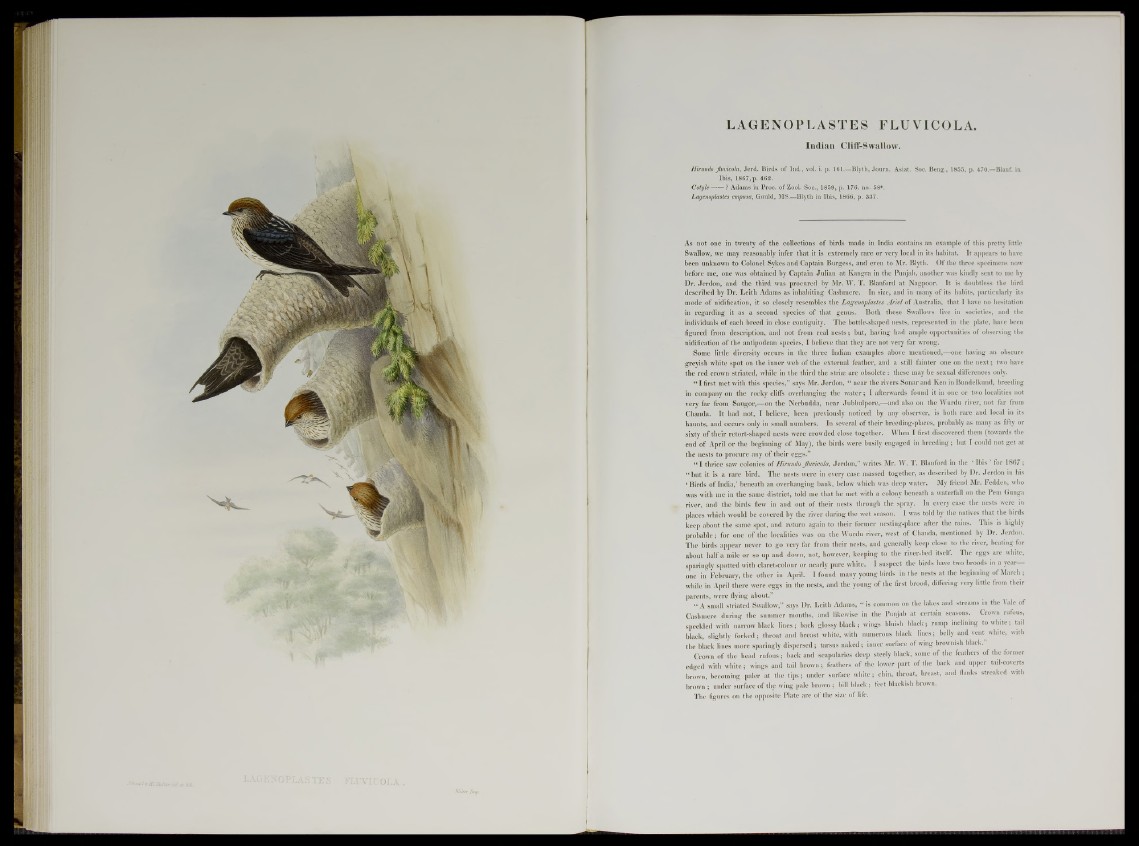
LAGENOPLASTES FLUVICOLA.
In d ian CliiF-Swallow.
Hirundo Jluvicola, Jerd. Birds of Ind., vol. i. p. 161.—Blyth, Journ. Asiat. Soc. Beng., 1855, p. 470.—Blanf. in
Ibis, 1867, p. 462.
Cotyle ? Adams in Proc. of Zool. Soc., 1859, p. 176. no. 58*.
Lagenoplastes empusa, Gould, MS—Blyth in Ibis, 1866, p. 337.
As not one in twenty of the collections of birds made in India contains an example of this pretty little
Swallow, we may reasonably infer that it is extremely rare or very local in its habitat. It appears to have
been unknown to Colonel Sykes and Captain Burgess, and even to Mr. Blyth. Of the three specimens now
before me, one was obtained by Captain Julian at Kangra in the Punjab, another was kindly sent to me by
Dr. Jerdon, and the third was procured by Mr. W. T. Blanford at Nagpoor. It is doubtless the bird
described by Dr. Leith Adams as inhabiting Cashmere. In size, and in many of its habits, particularly its
mode of nidification, it so closely resembles the Lagenoplastes Ariel of Australia, that I have no hesitation
in regarding it as a second species of that genus. Both these Swallows live in societies, and the
individuals of each breed in close contiguity. The bottle-shaped nests, represented in the plate, have been
figured from description, and not from real nests; but, having had ample opportunities of observing the
nidification of the antipodean species, I believe that they are not very far wrong.
Some little diversity occurs in the three Indian examples above mentioned,— one having an obscure
greyish white spot on the inner web of the external feather, and a still fainter one on the next; two have
the red crown striated, while in the third the striae are obsolete: these may be sexual differences only.
“ I first met with this species,” says Mr. Jerdon, “ near the rivers Sonar and Ken in Bundelkund, breeding
in company on the rocky cliffs overhanging the water; I afterwards found it in one or two localities not
very far from Saugor,-—on the Nerbudda, near Jubbulpore,— and also on the Wurdu river, not far from
Chanda. It had not, I believe, been previously noticed by any observer, is both rare and local in its
haunts, and occurs only in small numbers. In several of their breeding-places, probably as many as fifty or
sixty of their retort-shaped nests were crowded close together. When I first discovered them (towards the
end of April or the beginning of May), the birds were busily engaged in breeding; but I could not get at
the nests to procure any of their eggs.”
“ I thrice saw colonies of Hirundo jluvicola, Jerdon,” writes Mr. W. T. Blanford in the ‘ Ibis ’ for 1867;
“ but it is a rare bird. The nests were in every case massed together, as described by Dr. Jerdon in his
‘ Birds of India,1 beneath an overhanging bank, below which was deep water. My friend Mr. Fedden, who
was with me in the same district, told me that he met with a colony beneath a waterfall on the Pern Gunga
river, and the birds flew in and out of their nests through the spray. In every case the nests were in
places which would be covered by the river during the wet season. I was told by the natives that the birds
keep about the same spot, and return again to their former nesting-place after the rains. This is highly
probable; for one of the localities was on the Wurdu river, west of Chanda, mentioned by Dr. Jerdon.
The birds appear never to go very far from their nests, and generally keep close to the river, beating for
about half a mile or so up and down, not, however, keeping to the river-bed itself. The eggs are white,
sparingly spotted with claret-colour or nearly pure white. I suspect the birds have two broods in a year
one in February, the other in April. I found many young birds in the nests at the beginning of March ;
while in April there were eggs in the nests, and the young of the first brood, differing very little from their
parents, were flying about.”
“ A small striated Swallow,” says Dr. Leith Adams, “ is common on the lakes and streams in the Vale of
Cashmere during the summer months, and likewise in the Punjab at certain seasons. Crown rufous,
speckled with narrow black lines; back glossy black; wings bluish black; rump inclining to white; tail
black, slightly forked; throat and breast white, with numerous black lines; belly and vent white, with
the black lines more sparingly dispersed; tarsus naked; inner surface of wing brownish black.”
Crown of the head rufous; back and scapularies deep steely black, some of the feathers of the former
edged with white; wings and tail brown; feathers of the lower part of the back and upper tail-coverts
brown, becoming paler at the tips; under surface white; chin, throat, breast, and flanks streaked with
brown ; under surface of the wing pale brown ; bill black; feet blackish brown.
The figures on the opposite Plate are of the size of life.